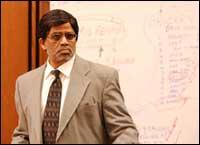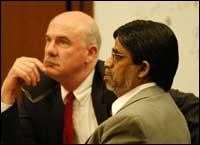 | « Back to article | Print this article |
 One defense witness thought Biswanath Halder was something like Mel Gibson's character in the film Conspiracy Theory. Halder, who lived in an attic in a three-storied house in Cleveland, Ohio, had hardly any furniture but his house was filled with boxes and boxes of magazines and newspapers.
One defense witness thought Biswanath Halder was something like Mel Gibson's character in the film Conspiracy Theory. Halder, who lived in an attic in a three-storied house in Cleveland, Ohio, had hardly any furniture but his house was filled with boxes and boxes of magazines and newspapers.
Halder, who was found guilty recently of holding some 150 students and professors hostage and killing one student on May 9, 2003, could get the death sentence. The sentencing phase of the trial has just started in a courtroom in Cleveland, Ohio.
Forensic Psychologist Jeffrey Smalldon, who has examined many serial killers told the jurors on January 19, the second day of the sentencing process, that Halder, 65, was convinced that his seven-hour long violent siege of the business school of Case Western University was justified. "Violence is essential!," Halder declared recently in describing the siege, Smalldon told the jury that was taking copious notes.
He was fighting cyber criminals, Halder told the psychologist. Halder added that by striking at the university, which Halder blamed for allegedly shielding a student and employee Shawn Miller who had reportedly hacked his Website, he made the world a safer place. His goal was to "liquidate" the university and that is why he entered the campus armed with over 1,000 rounds of ammunition, the psychologist said. Halder told him. "By doing what I did I saved the mankind."
Halder also told it (cyber crime) "Will never be allowed to happen again." And he added that he decided to act against the university because he believed it was paying reporters to write negative stories on him. Halder was convinced that everyone from Federal Bureau of Investigation and the judges were corrupt and had a thing or two against him.
And his action had "saved the world billions and trillions of dollars," Halder reportedly told Smalldon. Though Halder boasted about his mastery of mathematics and business, he also admitted to Smalldon that he had "lived a subhuman life" since his arrival in America in 1969 ostensibly to study. He could never have contact with his family in India, especially his only sibling, a sister, or have a girl friend because he was always short of money.
The psychologist, who emphatically told the jury that Halder was mentally ill, also added that the killer still had the capacity to distinguish right from wrong. Though he expressed regret for his action, Halder never showed any remorse, Smalldon added.
But Halder did not have a history of violence till the May 9, 2003 shootout, Smalldon said answering a question by defense lawyer Kevin Cafferkey. And he has created no violence in the jail, Smalldon added.
This is the first time the jury has heard about Halder's mental illness. It was not allowed during the trial because judge Peggy Foley Jones ruled that it did not meet the legal definition.
Cafferkey also said that Halder, who studied at various universities before going to Case Western for a business degree five years ago and could not hold any job for more than two years, had mental disorders since at least 1980.
An alcoholic, Halder has been sober for over 15 years.
It will take the jury a few days to decide whether Halder should serve a life sentence or go to the electric chair. Halder, who is being described by several defense witnesses as "grandly disillusioned," sits with his three court-appointed lawyers in the court with an impassive face but taking copious notes that he passes on to his defense team.
Dressed in a gray sports jacket and a white shirt, with a sober colored tie, and a $150 wig, the man described by one of his classmates at Case Western as someone who wore the same clothes day after day, Halder seldom looks at the jury or witnesses for the defense, who offer damning testimony against him. All in the hope of showing that his action was triggered by severe mental problems.
One of the defense lawyers, Cafferkey told the jurors on January 17 that Halder, "the bizarre little man who no one befriends" is mentally ill. He must spend the rest of his life in prison, Cafferkey added. He can "never live in society because of his actions of May 9, 2003," he added.
The forensic psychologist Smalldon said Halder was "one of the most isolated people I've ever evaluated."
Former neighbor Philip Helon, a law student when he lived in the same three-story building as Halder about five years ago, described Halder as someone who always appeared lonely. And had no friends or family members visiting him.
He also described Halder as "a little off" and as someone who was always obsessed with Shawn Miller, a Case Western University employee.
Halder had unsuccessfully sued the university and Miller more than three years before Halder went on a rampage in May 2003, dressed in military fatigues, wearing a helmet and a bulletproof west.
"The very first thought, at least from what I recall, when I heard a sole gunman was in the university, my instinct was, could that possibly be Biswanath," said Helon.
Helon also said that he occasionally invited Halder to a party but he declined the invitation.
When Helon gave Halder a sweater for Christmas and asked him to join him for a photograph, Halder resisted the idea, saying that he was too ugly. But he finally posed.
Assistant Cuyahoga County Prosecutor Rick Bell appealed on January 17 to the jury to sentence Halder to death and described him as a selfish man who plotted the rampage for over two years, buying one of the two guns he took with him to the campus soon after he lost the civil suit against Shawn Miller and the university.
The jury heard from Smalldon that Halder told him during an interview for the defense that Halder's Website, meant for Indian businessmen, could have made an impact of "billions and trillions" of dollars in 22 months had it not been hacked. Coming from a man who had no success in business since his 1969 arrival in America, the boast showed how delusional Halder was, Smalldon added.
Bell, who has sought vigorously to discredit Smalldon, had called during the trial the defense arguments that Halder did not commit a premeditated crime as unreal.
 According to John Laskin, one of the attorneys for Halder, the latter said he went into Peter B Lewis Building when he expected it to be nearly empty. He just wanted to protest. But when he lost his eyeglasses, he panicked, and shot blindly killing one student and wounding two others, then fired at police -- blindly, because he had lost his eyeglasses, the lawyers argued.
According to John Laskin, one of the attorneys for Halder, the latter said he went into Peter B Lewis Building when he expected it to be nearly empty. He just wanted to protest. But when he lost his eyeglasses, he panicked, and shot blindly killing one student and wounding two others, then fired at police -- blindly, because he had lost his eyeglasses, the lawyers argued.
"Are you kidding me?" Bell retorted in his closing argument, The Cleveland Plains Dealer reported. "This [defense] is an affront -- an affront to that [Wallace] family back there in the courtroom. Halder is a sociopath.
It angers me that [Halder] could be portrayed as some sad, strange little man -- that's not the case," Bell said. "He planned this for a long time."
Halder won a victory of sorts when Judge Peggy Foley Jones dismissed terrorism charges against him. Had he been found guilty on that charge, a death sentence seemed certain but now he could be sentenced to a life term, eligible for parole after 28 years
Photographs: Paresh Gandhi
Also read: .